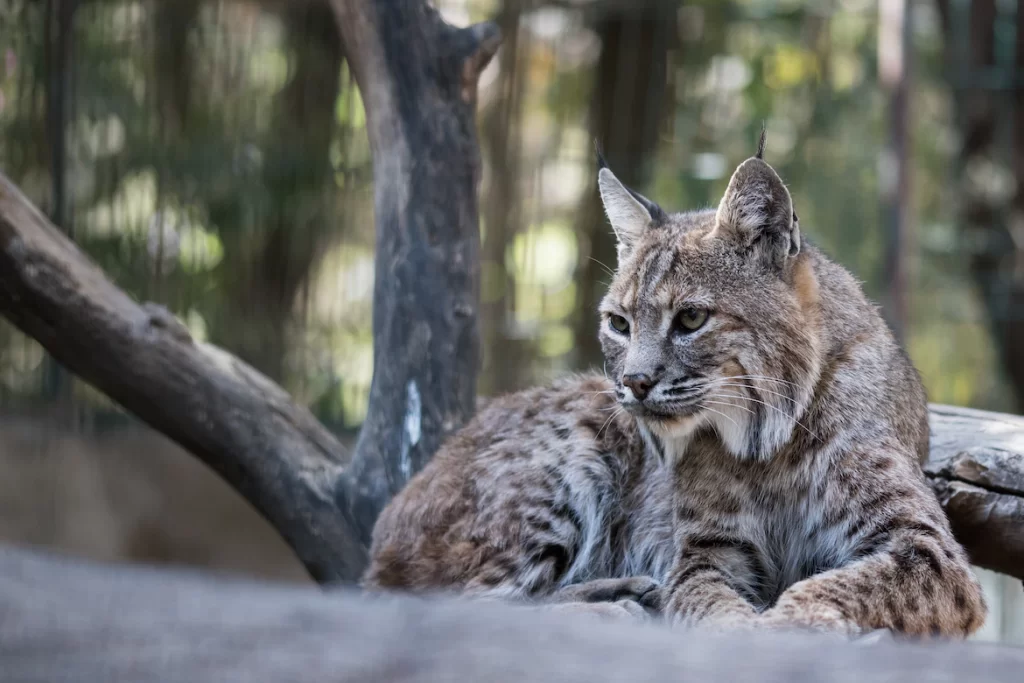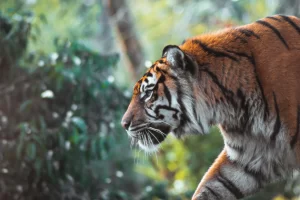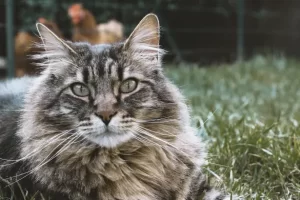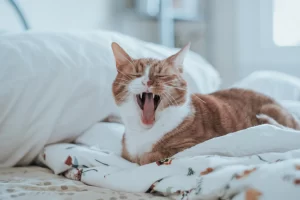Last updated on February 6th, 2023 at 12:31 am

Brief history of bobcats
Further familiarized as the red lynx, the bobcat is a North American moderate-sized cat. It stretches from southern Canada to Oaxaca in Mexico, traversing the majority of the adjacent United States. Because of its widespread dissemination and high population, it has been classified as Lowest Worry on the IUCN Red List since 2016. Despite widespread hunting for both sport and fur leading to deteriorating in certain regions, some people love having bobcats as pets. It gets its name from the black bars on its forelimbs and the coal-tipped, stout tail. It can grow to be up to 125 cm long including the tail which is 50 inches.
It is a versatile carnivore that can be found in forested zones, semidesert, urban edges, forest edges, and marshland habitats. It still exists in a portion of its native range; however, its populations are threatened by American Jackal and domesticated animals. Despite its preference for rabbits and hares, the bobcat also goes hunting insects, chickens, geese and other birds, small rodents, and deer. Prey classification is influenced by area and ecosystems, as well as period and ample supply. The bobcat, like most cats, is protective and mostly unsociable, with some similarities in home ranges. It marks its territory in a variety of ways. It characterizes its territory with claw marks and accumulation of urine or feces, among other things. The bobcat mate from winter to spring and has a 2-month procreation period.
There are 2- subclass acknowledged: one east of the Great Plains and one west of the Great Plains. It appears in some narratives of native peoples of North and Central America, as well as in the folklore of European-offspring Americans.
Bobcats’ characteristics and behaviors
Except for northern Canada, American bobcats can be discovered in the majority of North America.
They can live in a variety of natural environments, such as woodlands, mountain ranges, brushland, semidesert, densely forested farmland, and conifer swamps, and are extremely prevalent in suburban and urban regions.
Bobcats have numerous similarities with house cats as well as those of true wildcats. You might consider adopting bobcats as pets, but do you know what their characteristics and behaviors are? Let’s read on to find out.
Body characteristic
The bobcat has a brown coat with black or dark brown spots. Its tail is black-banded. Fur tufts emerge from the cheeks and ears, despite being relatively short compared to other types of wild cats. The edge of their ears has a white mark, as does the bottom part of their tails. These white characteristics are essential for kittens. The white marks on the ears help kittens pursue their mother in the twilight. If they lag, the mother will then notify them and raise her tail to reveal the white spot beneath.
Bobcats are crepuscular
Bobcats are crepuscular, which means they are energetic at both sunrise and sunset. Throughout the day, they wander freely between two and seven miles or 3 to 11 km and relax and take naps in a den either a hollow tree or a rock crevice.
They are territorial
They are extremely territorial, leaving odors and scratch marks on tree trunks to define their territory.
They are shy and elusive
Bobcats are shy, elusive creatures that are mostly active at night, hence they are hardly ever seen by humans. They could perhaps move 3 to 7 km in the twilight, moving and preying on the land surface, despite their climbing ability. They rest in enclosures, rock crevices, hollow trees, and undergrowth throughout the day. Bobcats are active all year long.
Bobcats are curious and affectionate
Bobcats as cats are curious, affectionate, and less tense than their wild mates. One custodian even maintains their pet bobcat with their pet muntjac deer, asserting that bobcats will embrace other species of animals into their group if brought up with them, which is the reason they can preserve what might ordinarily be a fantastically appropriate prey animal for the cat.
Bobcats are solitary
They are solitary cats that only socialize during the mating season. The mating period occurs in February and March, but it can occur at any time between November and August. Females reach sexual maturity when they are about one year of age, while males reach sexual maturity around 2 years. Over the mating period, both males and females have lots of partners. The incubation period lasts 60 to 70 days, with the female typically having a litter of three to six kittens, though this can vary. After 2 months of nursing, the mother introduces animal flesh to her kittens. When the kittens are old enough, the mother trains them how to prowl.
What are the risks and challenges you should expect from having bobcats as pets?
Attack pets and livestock
Humans are very seldom attacked by bobcats as pets. They may, nevertheless, present a risk to pets and livestock. These powerful cats predate on domesticated animals such as house cats, poultry, lambs, goats, and small pigs. Furthermore, bobcats use urine and feces to indicate their territory, in addition to scratching and tearing up grasslands, culminating in unnatural-looking heaps of rubbish and dirt with a potent, skunky odor.
Difficult to prohibit their invasion
Bobcats are especially challenging to manage due to their higher likelihood to come back once they have marked a sphere of influence or found prey in sections of land. This is why caging and relocating them is so difficult. Confining them is not only prohibited in certain states, but it also doesn’t address the underlying cause of the crowding.
If dead species are not removed from the land after a bobcat has been captured and eliminated, a new bobcat will most probably replace it. Calling qualified wildlife specialists is the most efficient way to deal with bobcat difficulties securely and efficiently.
Difficult feeding requirements
Bobcats should be nourished with a raw-food diet that has been researched extensively to guarantee adequate nourishment from organ meats, bones, muscle meat, and any other additional aspects of nutrients, furthermore to the whole prey items. Live nutrition is not only unwarranted but also cruel.
Food, activity bobcats enjoy
Bobcats are meat eaters and foragers who primarily feed on snowshoe hares in the north and cottontail rabbits in the south. Squirrels, mice, rabbits, lizards, snakes, birds, and bats are also prey. When food is scarce, they will even venture after huge prey such as deer. The bobcat goes hunting stealthily but produces a lethal blow with a 10-foot-long jump springing into action. If necessary, they will also forage on the remnants of domesticated animals quashed by other animals. Bobcats hunt their prey, creeping closer and closer until they can launch an attack. Their lethal advancement can encompass up to ten feet in length or 3 meters. They could also jump considerably enough to capture birds flapping close to the earth’s surface.

What states are legal to keep bobcats as pets?
Keeping bobcats as pets without a license is acceptable in many states. Pet bobcats are legitimate in Nevada, Alabama, North Carolina, Wisconsin, and South Carolina. Acquired or tamed bobcats are regarded as appropriate pets in these states. Other states might necessitate a bobcat license or certification. These states might necessitate a mating approval or exotic pet license, and your bobcat may be subordinate to regular housing assessment to make sure he is residing in proper circumstances.
Arizona, Florida, Delaware, Indiana, Maine, Missouri, Mississippi, Oklahoma, North Dakota, Pennsylvania, South Dakota, Rhode Island, Wisconsin, and Texas are among the states that recognize bobcats as pets with authorization or certification. If you got a bobcat before laws made it illegal to own a tamed bobcat, you might be allowed to keep your pet. furthermore, it’s always a good idea to double-check local limitations and governance.
What Special Permits Are Required in these states? Domesticated bobcats need a distinctive authorization in some states. Other states need permits if you intend to keep bobcats for furring. Authoritative licenses may also be required if you intend to produce offspring of your bobcats or ship bobcats from another state. Furthermore, permits may be necessary if you intend to offload overseas or sell bobcats throughout all state lines. Idaho, Utah, and Wyoming are among the states that necessitate a license.
Conclusion
Bobcats should be left alone in their natural habitat. They may appear adorable and affectionate, but their animalistic tendencies and intuitions can potentially trigger them to change their mind at any time, even in the safest home. Bobcats must be handled with dignity and provided adequate room. Bobcats deliberately avoid humans in the jungle. Desiring bobcats can cause excessive anxiety for the animals as well as a hazard to you. Maintaining bobcats as pets set the animal up for disappointment and put you in a terrible spot where the untamed cat you decided to keep as a pet injures or kills an individual or other people’s pets.


